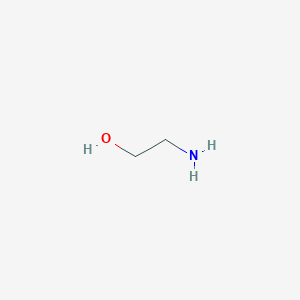| Synonyms |
Click to Show/Hide the Synonyms of This DIG
Ethanolamine; 2-aminoethanol; monoethanolamine; 141-43-5; colamine; Aminoethanol; 2-Hydroxyethylamine; Glycinol; Ethanol, 2-amino-; Olamine; 2-Amino-1-ethanol; 2-Aminoethan-1-ol; Ethylolamine; beta-Hydroxyethylamine; 2-Hydroxyethanamine; 1-Amino-2-hydroxyethane; 2-Aminoethyl alcohol; beta-Aminoethyl alcohol; Aethanolamin; 2-Ethanolamine; Thiofaco M-50; beta-Aminoethanol; 2-amino-ethanol; MEA (alcohol); beta-ethanolamine; Kolamin [Czech]; USAF EK-1597; Kolamin; Monoaethanolamin; Aethanolamin [German]; Caswell No. 426; Etanolamina [Italian]; 2-Aminoaethanol; 2-Amino ethanol; Monoaethanolamin [German]; 2-Aminoaethanol [German]; 2-Aminoetanolo [Italian]; Glycinol (monoethanolamine); UN2491; CCRIS 6260; HSDB 531; Hydroxyethylamine; AI3-24219; MFCD00008183; EPA Pesticide Chemical Code 011601; UNII-5KV86114PT; ETHANOL AMINE; CHEBI:16000; CHEMBL104943; Envision Conditioner PDD 9020; 5KV86114PT; ethanol-amine; Ethanolamine, 99%; Ethanolamine-15N; UN 2491; Monoethanolamine (NF); Monoethanolamine [NF]; NCGC00090789-02; Ethanolamine, ACS reagent; 2-Aminoethanol (Ethanolamine); 2-Aminoethanol Reagent ACS Grade; Etanolamina; Ethanolamine or ethanolamine solutions [UN2491] [Corrosive]; Ethanolamine, 99%, AcroSeal(R); 2-Aminoetanolo; monoethanol amine; MEA-LCI; EINECS 205-483-3; ethanolamin; ethanolarnine; hydoxyethylamine; b-Aminoethanol; b-Ethanolamine; MEA 90; H-Glycinol; 2 -aminoethanol; b-Hydroxyethylamine; ethanol, 2-amino; 2-hydroxylethylamine; H-Gly-ol; Olamine [INN]; .beta.-Aminoethanol; .beta.-Ethanolamine; b-Aminoethyl alcohol; Ethanolamine solution; 2-hydroxy-ethylamine; 2-hydroxyethyl amine; 2-hydroxyethyl-amine; 33598-78-6; 2-amino-ethan-1-ol; 2-hydroxy- ethylamine; Ethanolamine or ethanolamine solutions [UN2491] [Corrosive]; 2-hydroxy-1-ethylamine; ACMC-1ADOH; .beta.-Hydroxyethylamine; Ethanolamine, >=98%; Ethanolamine, >=99%; NH2CH2CH2OH; .beta.-Aminoethyl alcohol; DSSTox_CID_2000; Ethanolamine, AR, 99%; 2-$l^{1}-azanylethanol; bmse000276; Epitope ID:120354; NH2C2H4OH; EC 205-483-3; 2-Aminoethanol, redistilled; 2-aminoethanol,hydrochloride; DSSTox_RID_76452; DSSTox_GSID_22000; Ethanolamine: 2-aminoethanol; BIDD:ER0367; Ethanolamine, LR, >=99%; 2-$l^{1}-oxidanylethanamine; BDBM7973; Ethanol-1,1,2,2-d4-amine; DTXSID6022000; Ethanolamine, analytical standard; Ethanol, 2-amino- (8CI,9CI); STR00417; ZINC8214617; Tox21_400020; ANW-20621; c0594; STL199164; Ethanolamine or ethanolamine solutions; Ethanolamine, for synthesis, 99.0%; AKOS000245055; DB03994; MCULE-5175116598; NE10561; 1H-INDOLE-5-CARBOTHIOICACIDAMIDE; Ethanolamine, ACS reagent, >=99.0%; Ethanolamine, ReagentPlus(R), >=99%; Ethanolamine, USP, 98.0-100.5%; beta-Aminoethyl alcohol beta-Ethanolamine; NCGC00090789-01; NCGC00090789-03; BP-21017; BP-24368; BP-31055; CAS-141-43-5; Ethanolamine, SAJ first grade, >=99.0%; A0297; Ethanolamine, JIS special grade, >=99.0%; FT-0777922; EN300-19392; 3319-EP2277622A1; 3319-EP2281816A1; 3319-EP2281818A1; 3319-EP2295426A1; 3319-EP2295427A1; 3319-EP2305642A2; 3319-EP2308510A1; 3319-EP2308562A2; 3319-EP2308828A2; 3319-EP2311815A1; 3319-EP2371809A1; 3319-EP2371811A2; C00189; D05074; 27253-EP2281563A1; 27253-EP2281818A1; 27253-EP2286811A1; 27253-EP2292611A1; 27253-EP2298731A1; 27253-EP2298755A1; 27253-EP2298767A1; 27253-EP2305660A1; 27253-EP2305679A1; 27253-EP2308828A2; 27253-EP2311818A1; 27253-EP2314575A1; 27253-EP2314587A1; 27253-EP2371811A2; 66285-EP2272516A2; 66285-EP2289892A1; 66285-EP2292597A1; 66285-EP2295399A2; 66285-EP2298728A1; 66285-EP2308851A1; 91851-EP2281822A1; 91851-EP2305668A1; 91851-EP2377847A1; Q410387; Ethanolamine, purified by redistillation, >=99.5%; J-508043; 587CE5AA-008A-469C-AB39-82CC4D0CA779; F2190-0367; Ethanolamine, puriss. p.a., ACS reagent, >=99.0% (GC/NT); Ethanolamine, liquid, BioReagent, suitable for cell culture, >=98%; Trolamine impurity A, European Pharmacopoeia (EP) Reference Standard; Ethanolamine solution, for peptide synthesis, ~74% (T), ~70% in methanol; Monoethanolamine, United States Pharmacopeia (USP) Reference Standard; Monoethanolamine, Pharmaceutical Secondary Standard; Certified Reference Material; 85047-08-1; Ethanolamine, PharmaGrade, USP/NF, Manufactured under appropriate GMP controls for Pharma or biopharmaceutical production
|
 click to show the detail info of this DBT
click to show the detail info of this DBT

